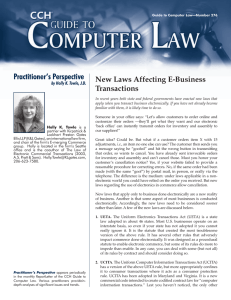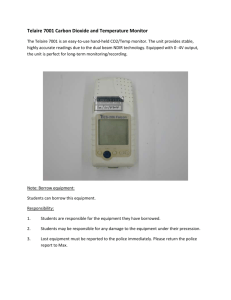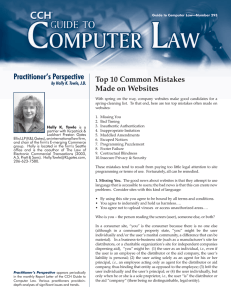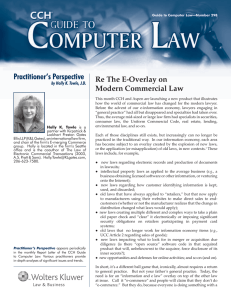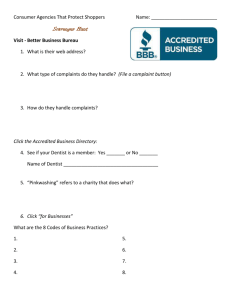e-commerce law&policy cecile park publishing FEATURED ARTICLE
advertisement
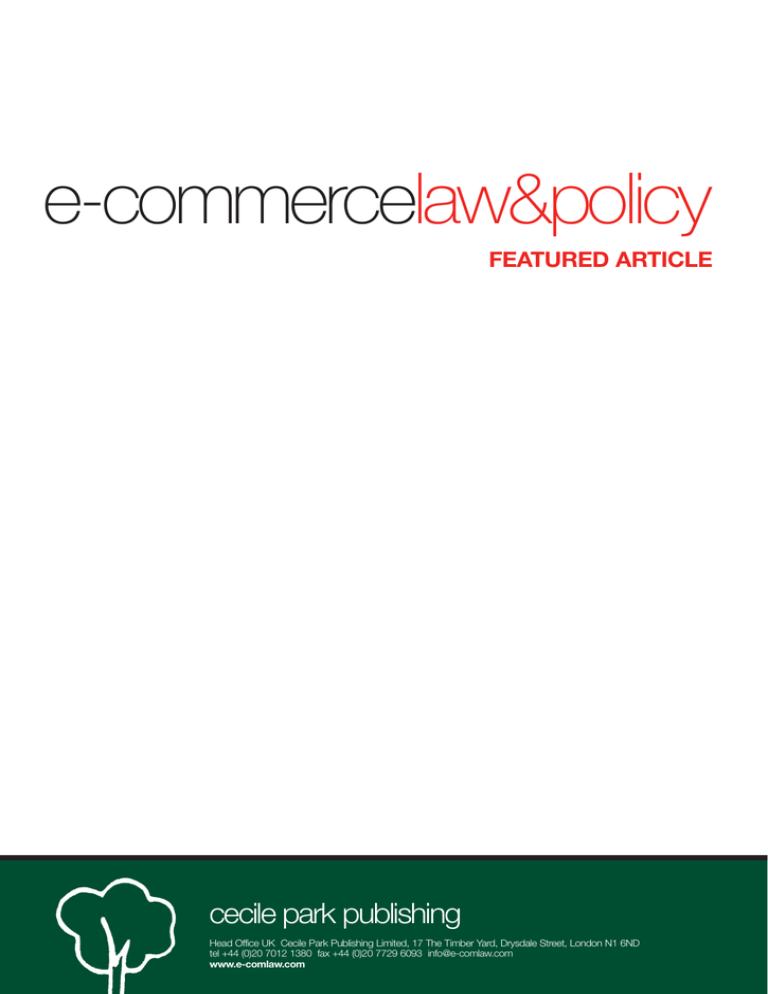
e-commercelaw&policy FEATURED ARTICLE 03/09 cecile park publishing Head Office UK Cecile Park Publishing Limited, 17 The Timber Yard, Drysdale Street, London N1 6ND tel +44 (0)20 7012 1380 fax +44 (0)20 7729 6093 info@e-comlaw.com www.e-comlaw.com E-CONTRACTS Old contracts in new realms: keeping track of the changes As online contract law develops, it may be helpful to take an updated look at some of the approaches used in the US. Holly K.Towle, Partner at K&L Gates, looks at several emerging trends or needs that companies contracting online need to bear in mind to avoid complex legal proceedings. Online contracts written for an offline world, but made or performed electronically, can have unintended consequences. For example, if a party must ‘deliver’ a document, posting it online might only meet a ‘make available’ requirement. When a contract calls for ‘written’ amendments, does that contemplate paper only or does it encompass email statements? When an ‘integration’ or ‘merger’ clause says the agreement in the scroll box is the ‘entire’ agreement of the parties, is that true or did one party really intend for online consents, disclosures and terms of use also to apply? In short, contracts written for a physical world should be updated for electronic settings1. Further, within e-settings, contracts written for one setting need to be adapted to others, e.g., a contract written assuming a desktop computer screen will not necessarily work for mobile devices. E-SIGN consumer rule 15 U.S.C. §7001(c) is a special consumer rule in the federal Electronic Signatures in Global and National Commerce Act (‘the Act’). The Act does not really have global reach, but by using that word, Congress created the acronym ‘ESIGN’ for this basic enabling statute for electronic signatures and records in the US. Section 7001(c) contains a consumer protection rule that is perilous to overlook. It pertains when a e-commerce law and policy january 2011 company is required to provide to a consumer (an individual acting primarily for personal, household or family purposes) information (e.g., a disclosure) in ‘writing’ (on paper). In the US, such consumer protection disclosures must be provided by a range of industries, e.g., financial institutions. When a company is required to provide such a written disclosure, it may not substitute an electronic version unless it first complies with §7001(c). This requires three steps involving details that can be surprisingly difficult to meet in context. Very generally, the company wanting to substitute an electronic disclosure for paper must: provide a clear and conspicuous E-SIGN statement consisting of specified content about dealing electronically, and listing software and hardware needed for access and retention; obtain the consumer's affirmative consent to substitution; and obtain or confirm that consent electronically in a manner reasonably demonstrating the consumer's ability to access the econsumer protection disclosure. If there is a change in software and hardware, a fourth step looms, i.e., providing notice of changes and reconfirming the third step. Only after meeting §7001(c) may the consumer protection disclosure be provided electronically paper. This is harder than it sounds and a consequence of non-compliance is a deemed failure to provide the consumer protection disclosure2. Additional e-regulations or ‘egloss’ Even contracts complying with the first and second steps might not comply with regulations adding a gloss to how things must be done electronically. For over a decade, the focus in the US has been on whether it was possible to meet electronically a law requiring a ‘writing’ or ‘signature’, and ‘enabling’ laws have, in general, said ‘yes’3. However, a new generation of regulations is emerging with additional, special rules regulating how that must be done or simply extending to businesses, consumer protections akin to E-SIGN §7001(c)4. Some of this ‘e-gloss’ will be invalid under E-SIGN restrictions on regulators, but not all. An example of ‘e-gloss’ is a new Federal Trade Commission (FTC) rule for mortgage foreclosure services. Its definition of ‘clear and prominent’ specifies details for all of these communications: textual (written or printed, including computer screen text), oral, audible, video and interactive media (e.g.,internet, software and online services). The portion of the definition for textual communications and interactive media illustrates the scope of detail found in this kind of ‘e-gloss’5. Finding such rules or ‘e-gloss’ requires locating and reviewing the exact background law for each subject matter of the contract. This has long been the task of attorneys, but it is increasingly arduous because of its random nature and the fact that it is often buried in non-uniform guidance, commentary or interpretations. Attribution It does little good to make a contract if the company seeking to enforce it cannot attribute it to the intended party: if contracting procedures create ambiguity regarding who clicked ‘I Agree’ or typed in a signature or is referenced, a company may find itself without a contract, or may have one with or pertaining to someone other than intended. This problem can arise from ambiguous 03 E-CONTRACTS language or the inability to know who made the agreement. In Prudential Insurance Co. of America v Dukoff6, an online life insurance application was too ambiguous to allow summary judgment on who contracted with the company. The choices were: the husband - claimed by one side to have filled out the application on his wife - the wife, claimed by one side to have filled out the application on herself, or both? The answer mattered to several claims, including under agency law and an insurance law statute restricting the ability of the company to contest statements made by the ‘applicant’. The company could not prove who the ‘applicant’ was. In Dillard Store Services, Inc. v Kerr7, a department store could not enforce an arbitration agreement against its sales clerk. The clerk had not turned up for the right shift and was cautioned to meet her online schedule. She said she had not seen it and her manager took her to an employee-available computer in the cafeteria to help her set up an employee account, a process which included obtaining employee consent to an arbitration agreement. The question came down as to who consented - the employee, the manager or someone else involved in the process? Because the store could not reasonably prove the answer, it could not enforce the arbitration contract. Data protection The above illustrates the need under contract law to ‘know your counterparty’, but there is also a developing need under US identity theft prevention laws and to avoid, according to the FTC, the unfair act of not adequately authenticating customers8. Dealing with the wrong person (the identity thief) carries increasing 04 Finding such rules or ‘egloss’ requires locating and reviewing the exact background law for each subject matter of the contract. This [task] is increasingly arduous exposure for the company so dealing and the person whose identity is stolen. Both are victims of the identity thief9. However, efforts taken to know your counterparty can conflict with data protection laws, creating the unenviable position of being caught between a rock and a hard place10. Incorporated contract terms Contracts increasingly attempt to incorporate by reference separate terms posted online and, often, this does not work for a range of reasons11. Case law tends to be fact dependent and ‘outcome’-based, particularly if it is cumbersome to access the terms. A recent example is an unpublished case12 where an installation CD contained a tenpage clickwrap agreement in scroll box asking users to ‘Please read’ a Subscriber Agreement posted online. The court refused to grant a motion to avoid trial for several reasons and held that: ‘As presented, the Clickwrap Agreement does not clearly incorporate the Subscriber Agreement by reference and to reach the arbitration clause requires the user to leave the installation program, log onto the Internet (if possible), navigate to the proper page, and read the Subscriber Agreement, then return to the installation program's scroll down window to read the remaining ten pages of the High-Speed Internet Modem Installation Legal Agreement before choosing whether to agree to the terms. In addition, the arbitration issue is confused by the fact that the readily available agreements [in the scroll box] provide a forum in the court system for resolution of conflicts springing from the scroll box contracts. This creates an ambiguity regarding recourse in the event of a dispute.’ Access controls The FTC has begun to claim that having inadequate access controls to protect personal data is an unfair act. FTC enforcement actions have resulted in private settlement orders indicating what the FTC believes is appropriate for the service provider's system, its administrators and even it customers' systems. Several states also require businesses to implement and maintain reasonable security measures, including to protect personal information from ‘unauthorized access’13. Specific topic statutes and payment card organization rules State legislatures dive into this arena with non-uniform laws on random topics which are difficult to discover. A new California statute14 is illustrative and impacts formation of consumer subscription or membership contracts when services will be continuous or automatically renewed at the end of a definite term (e.g., annually). An example is a health club membership for which the annual fee is automatically charged to a payment card or directly debited from the consumer's bank account. Absent compliance, the statute converts provision of services or goods into an ‘unconditional gift’. It requires the service provider to make particular disclosures in a stated time and manner, provide a particular acknowledgement of order receipt, obtain ‘affirmative’ consent, and provide a particular notice of material changes and cancellation procedures. The statute makes it unlawful to make a charge or debit absent affirmative consent (subject to exceptions). This kind of statute applies in addition to already existing rules of payment systems and state or e-commerce law and policy january 2011 E-CONTRACTS federal laws such as federal Regulation E (which applies to preauthorized debits to consumer bank accounts)15, payment card organization rules for ‘recurring transactions’ and so on. Other payment card organization rules can also impact online contracting. An example is a Visa rule prohibiting ‘data passes’. As explained in a US Senate Committee report16, after customers have made a purchase but before completing sale confirmation, customers are presented with another offer which is actually from a third party but appears to be connected to the purchase. This appearance is buttressed because the first merchant has ‘passed’ data to the second, the consumer is not required to re-enter credit card information and, thus, may not realize a separate purchase is being made. Visa rules apparently expressly prohibit the practice as of 1 May 201017. Violation of this kind of payment card rule can result in a ‘chargeback’ of the transactions, and at least one court has viewed a high rate of ‘chargeback’ as evidence of consumer confusion in an unfair acts or deceptive practices claim18. Electronic records If there is a dispute, it does not do much good to have carefully formed a compliant contract if electronic records for it cannot be introduced into court, and erecords are more vulnerable to being rejected than paper. An illustrative case is In re Vee Vinhnee19, where a creditor was denied recovery because it did could not establish an evidentiary foundation for the accuracy of its electronic record keeping system. Note also that evidentiary rules are not the only relevant rules: some ‘e-enablement’ statutes such as ESIGN contain new e-record rules. e-commerce law and policy january 2011 Standard e-contract rules The following additional questions continue to be relevant: Does the user have notice a contract is being made20? Is the contract formed at the correct time and have requirements in basic ‘e-enabling’ laws been met or varied if allowed? Have required pre-contract disclosures been made and formatting requirements met, including for concepts such as ‘conscionability’, unfair acts or deceptive practices and any ‘e-gloss’ rules? Is there an opportunity to review and reject the contract terms (such as outlined in the Uniform Computer Transaction Act § 112)21? If terms cannot be reviewed until later, is there a right of return upon rejection of the later-delivered terms22? Is there a manifestation of assent to the contract by the party intended to be bound in the form (if any) required by applicable law? Holly K. Towle Partner K&L Gates (Seattle) holly.towle@klgates.com 1. For more examples and further discussion, see Towle, Holly, ‘Modern Contracts: Boilerplate Needs an Overhaul for the Information Economy’, Electronic Commerce & Law Report, 14 ECLR 1583, 11/04/2009. 2. For a review of § 7001(c), see Towle, Holly, ‘The Law of Electronic Commercial Transactions’ (2003-2010, A.S. Pratt & Sons) at Chapter 11 (Consumer Law Issues in E-Commerce). 3. See footnote 2 (Chapter 4). 4. For example, the Internal Revenue Service has several times issued regulations containing variations of the ESIGN §7001(c) consumer rule for use with notices to businesses or in business settings to which E-SIGN does not apply. 5. 16 CFR 322.2(a)(1) and (4). 6. Prudential Insurance Co. of America v Dukoff, EDNY, No. 07-1080 (12/18/09). 7. Dillard Store Services, Inc. v Kerr, 2009 WL 385863 (D. Kan. 2009). 8. Footnote 2 (Chapters 15 and 16.06[2][c]). 9. See footnote 2 (Chapter 15). 10. See Towle, Holly, ‘Personal Data as Toxic Waste: A Data Protection Conundrum’, Privacy & Data Security Law Journal, June 2009. 11. Footnote 2 (Chapter 5.03[2][d]). 12. Grosvenor v Qwest Communications International, Inc., 2010 WL 3906253, unpublished. 13. See e.g., Cal. Civ. Code § 1798.81.5. 14. See CA Bus. & Prof. Code § 1760017606, at www.leginfo.ca.gov/cgibin/displaycode?section=bpc&group=17 001-18000&file=17600-17606 15. Footnote 3 (Chapter 11). 16. See ‘Aggressive Sales Tactics on the Internet and Their Impact on American Consumers’, by the Committee on Commerce, Science and Transportation, available from http://commerce. senate.gov/public/index.cfm? p=Search&num=&filter=0&q=%22Aggres sive+Sales+Tactics+on+the+Internet+an d+Their+Impact+on+American+Consum ers 17. See http://broadcast01p. visabroadcasts.com/doc/201004201249 36/28a6730974b8943ee0d6a34963ca4 0c3 (I say ‘apparently’ because the publicly posted set of Visa rules had, at the time I located the public press release URL, not been updated to include the rule and seem not to mesh with citations in the release. Many card organization rules are never publicly posted.) 18. See e.g., FTC v Grant Connect, LLC, Slip Copy, 2009 WL 3074346 (D NV 2009); decision also includes list of preliminary injunction requirements for defendants' ‘continuity program’ and its pre-authorized debits of consumer bank accounts. 19. In re Vee Vinhnee, 336 B.R. 437 (9th Cir. 2005). 20. See e.g., Specht v Netscape Communications Corp., 306 F.3d 17(2nd Cir. 2002) (insufficient notice). See also UCITA §§ 208 and 209 (2000)(ways to provide notice). 21. UCITA has only been adopted in two states, but it and its official comments are useful to understanding US common law and differences between contract laws written for sales goods (such as the Uniform Commercial Code Article 2 regarding sales of goods) and information licenses or access contracts. From a compliance perspective, courts have tended to require the same or less than UCITA since its issuance, so compliance by analogy can often be helpful in a setting where contract law for information transactions is not yet clear. 22. See UCITA § 209 (2000) (rules for some later-deliver terms). 05
